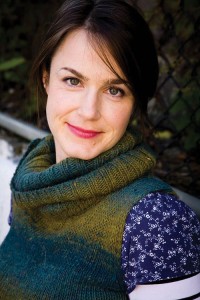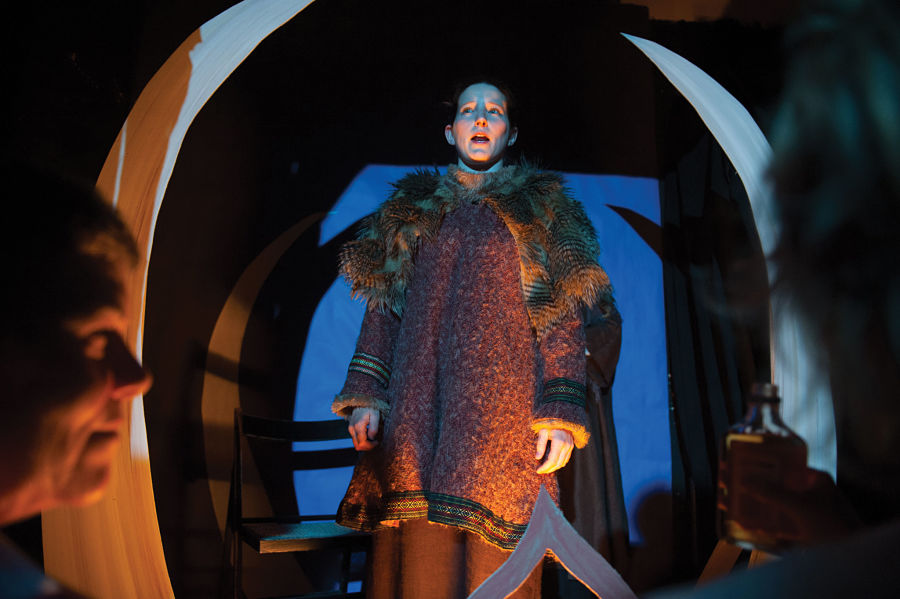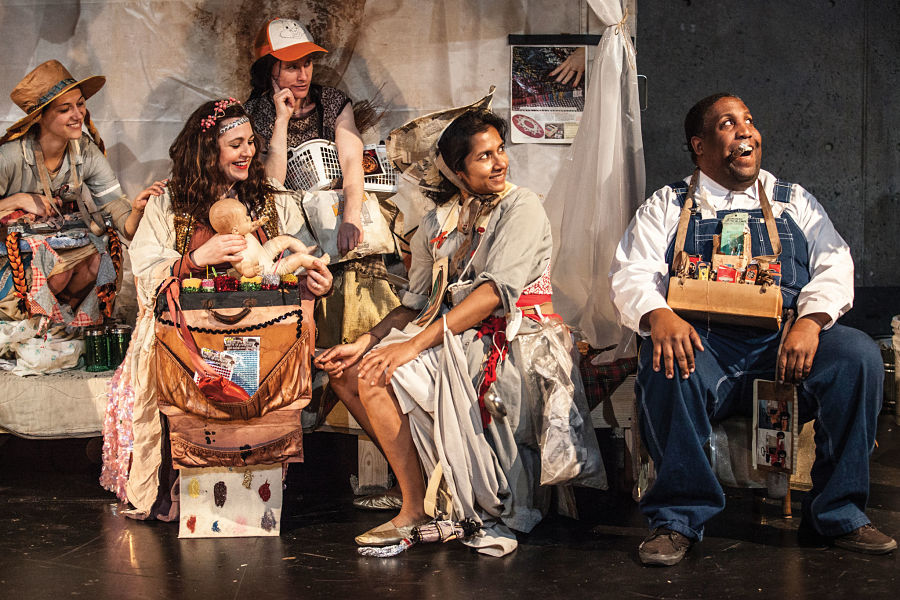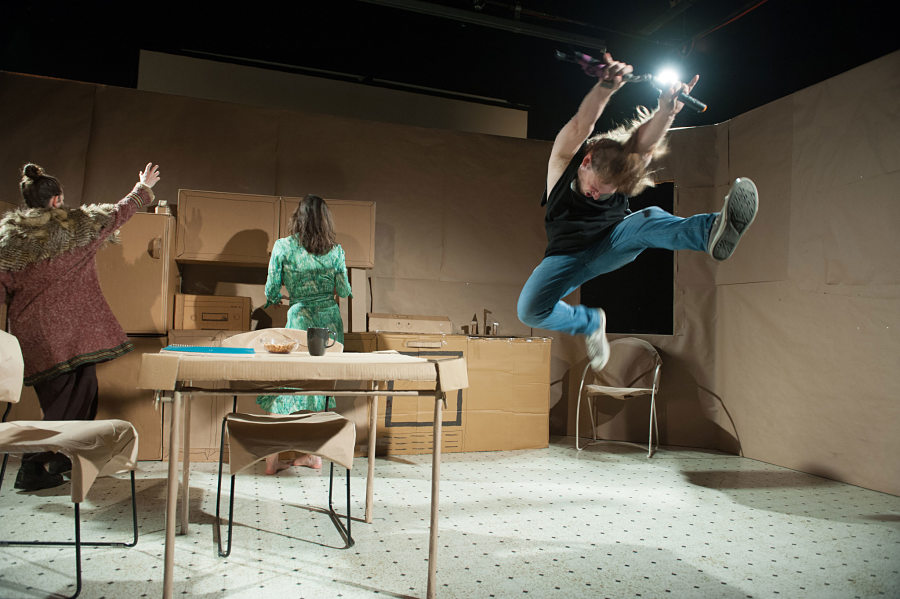If you’re unfamiliar with the work of playwright Sibyl Kempson, it would be useful to define it at the start. Trouble is, Kempson’s work tends to defy categorization, genre, or any standard methods of description. “There is no way to put her into any existing category,” says Antje Oegel, coeditor of 53rd State Press and Kempson’s agent. “I believe she is a category of her own—to quote Frank Hentschker, ‘There is post-symbolism, or Sibylism,’ and we will soon put artists into her category.”
Hentschker, executive director of New York City’s Martin E. Segal Theatre Center, adds that Kempson is “a true explorer” who is “never thinking about selling us something, always mysterious, always asking, not answering.”
“I think of Sibyl’s work as a form of life, not a kind of theatre,” says playwright compadre Karinne Keithley Syers, Oegel’s coeditor of 53rd State Press. “There’s a fundamental identification with vegetable matter in Sibyl’s work, with how things grow, the creepy superabundance and hypertrophies of both the natural and the psychic.”
Syers is speaking metaphorically—and not. Kempson’s trio of “vegetable plays” takes on asparagus (Spargel Time!), potatoes (Potatoes of August), and pumpkins (Ich, Kürbisgeist). The latter work, which Big Dance Theatre produced in 2012, is a kind of Halloween play, written in an invented language with riffs on German, Swedish, and old Norse. In Kürbisgeist the pumpkin deities get angry because the puritanical people of Earth have disrespected the land. It was the first show I saw in the wake of Hurricane Sandy, and it felt eerily appropriate.
Big Dance’s Kürbisgeist is just one example of Kempson’s work with ensembles. Her largest, most sprawling collaboration to date is arguably the Pig Pile, a three-year collaboration among Kempson and a gaggle of Austin groups: ScriptWorks, Fusebox Festival, Physical Plant, Rude Mechs, Rubber Repertory, and Salvage Vanguard Theater (with support from Full Stage USA). The resulting River of Gruel, Pile of Pigs (2013) led audiences on a site-specific journey for pointed reckonings between humans and the natural world, along with hilarious scenes, asides, and tangents. And the following year, From the Pig Pile: The Requisite Gesture(s) of Narrow Approach bowed.

Her latest work in New York is also company-based. A collaboration with Elevator Repair Service, Fondly, Collette Richland, opens at New York Theatre Workshop this month. An adaptation/riff on the work of Jane Bowles (see “Two Serious Ladies,” Aug. ’14), Fondly, Collette feels like an exemplar of a new theatrical genre wherein a literary work unfolds on the stage—perhaps fitting, given ERS’s reputation for staging classic books (Gatz, The Sound and the Fury). Despite its density, Fondly, Collette is deeply humorous, peppered with wordplay from a bygone age (“oh-preciate,” “perklate,” “d’voted”). The character of “Fritz” is invariably referred to in quotation marks, and a note at the start of the play informs us: “Whenever a sentence or paragraph is crossed out, it should be said in unison by all present, but under the breath, as if too ashamed to say the line aloud with proper projection. This technique is what has been called, in less conservative times, ‘breath of shame.’”
Kempson also ventured into company-building herself this year, inaugurating the troupe 7 Daughters of Eve Thtr. & Perf. Co. last spring with the show Let Us Now Praise Susan Sontag, a work drawing on such disparate sources as James Agee’s Let Us Now Praise Famous Men, essays by French symbolist painter Odilon Redon, Broadway musicals, and ancient myths.
Listing her upcoming projects takes us further into wild Kempsonian landscapes: 12 Shouts to the 10 Forgotten Heavens is a series of rituals created with playwright and phenomenologist Thomas Riccio, slated to happen four times over the course of a year (likely on solstices and equinoxes) for three years at the Whitney Museum. There’s also a Bigfoot/Sasquatch ritual project; a play loosely based on Mary Shelley called The Securely Conferred, Vouchsafed Keepsakes of Maery S.; a word-for-word translation of Norwegian playwright Knut Hamsun’s Ved Rigets Port: Forspil; and adaptations of Ibsen’s The Wild Duck (called Kyckling and Screaming) and An Enemy of the People infused with and informed by the work of rap giants Public Enemy and Chuck D.
I haven’t even mentioned such landmark works as Kempson’s The Secret Death of Puppets, Bad Girls, Good Writers, or Crime or Emergency, in which she played a multitude of characters while hollering Springsteen songs. As a performer, she is a delightful-to-watch crackpot.
Kempson may be hard to pin down, points out playwright Erin Courtney, because she “looks for inspiration in places that most playwrights do not.” Courtney, who teaches alongside Mac Wellman at Brooklyn College, where Kempson completed her MFA in 2007, adds, “One of these places is the power and complexity of nature, and our fear of it.”
A New Jersey native, Kempson now splits her time between New York City and the Pennsylvania’s Pocono Mountains. Much like her plays, she speaks in a rapid-fire mix of italics, exclamation points, sotto voce, and all-caps. She lets out full-throttle belly laughs often.
When we first spoke, she had recently completed a survival course. “I can now walk into the woods naked with a knife and not only survive but thrive,” she enthused. As we talked about her plays and writing process, that nature survival course proved a potent metaphor for what she’s up to artistically.
“Feminine thought is present in nature because there are no easy resolutions,” she said, adding that she has only recently recognized how the natural world drives her work. She didn’t set out to write a series of vegetable plays, she said; they simply emerged, er, organically.
Her writing process most often starts with Kempson alone responding to source materials and allowing herself to be pulled in different directions. Collaborative work then takes place during rehearsal periods, which is part of why she’s worked so much with companies, and now has her own. “I feel like my work is only half written on the page; a lot of writing happens once I stage a play, and I feel like I have to be more involved in the staging.”
As an associative writer and thinker, Kempson explained that she doesn’t “impose a structure on my writing at the outset. I focus on the details and then find associative pathways so that the structure emerges on its own.”
This letting-the-structure-emerge-on-its-own is an oft-touted strategy of playwrights in the Courtney/Wellman Brooklyn College universe (full disclosure: I count myself among their ranks). But Kempson’s interest in nature provides a certain twist on this approach.
“Part of our problem is that we’re stuck on this hero’s journey narrative, and it’s a very narrow way of looking at the world,” she declared. During the wilderness course, participants were taught “fox” and “weasel” walking—ways to not disturb or disrupt nature—as well as “wide-angle vision,” a way of seeing oneself as a part of the world. “If you change the way you are looking at the world, then you change the way you are thinking. It can even change your biorhythms,” Kempson said.
Indeed, fox walking and wide-angle vision proved revelatory for Kempson. “I’m a big woods person,” she said. “Usually it’s like, ‘Here I am! I’m walking though the woods!’” she proclaimed, adopting a kind of over-eager pioneer voice before acknowledging, “Even the syntax of that points to subject/object divide. It’s me walking through the woods. The me is separate from the woods. But with fox walking and wide-angle vision, I am not the center of the story.”

Part of Kempson’s quest—and one senses she’s on a quest when she talks about her plays and the state of the world—is to create alternative narratives and structures to the tried-and-true hero’s journey. “We’ve been trained to watch plays in a certain way and we get upset and frustrated and bored if a story isn’t that,” Kempson said. “So first, I want to discover new narrative structures. And second, I want to try to find a way to get them across without making people feel stupid.”
At this point she harkened back to the Brooklyn College let-it-emerge ethos, calling Wellman’s teaching “deeply feminist. It’s detail first, and then the structure reveals itself. Our reality isn’t just our five senses but it’s our imagination and our intuition—and until we start admitting that into our definition of reality, we’re only getting a small part of the picture and we’re destroying ourselves.”
Here we get to the health of the planet, a key subject for Kempson, who warned with almost gleeful end-times abandon, “We’re going to go way before the Earth does. We need to figure out what direction we want to go as humans. And we have to allow our feelings into our decision-making—even with science. That can be scary, but look at the damage science has done with the attitude of separating feelings from actions. ‘Oh, I’m not going to let myself feel about what I’m doing to this rodent or dog. I don’t feel anything about this bomb.’”
“I think Sibyl has a fundamental attraction to the experience of terrible energy: the bad-etymology link between terre (as in Earth) and terror,” says 53rd State Press’s Syers. Indeed, nature’s vengeance on humans for their neglect and abuse is never far from the surface of the Kempson universe.
The convergence of the personal and the spiritual in Kempson’s plays makes them feel both intensely individual but also intended for a collective experience; subversively political but not didactic. Is she trying to save us from ourselves? Could Kempson’s plays, with their questions and provocations, help us out of the mire?
Fondly, Collette Richland is as much about buried identities and the submerged feminine aspects of religion as it is a riff on the writing of Jane Bowles and an elegy for the middle class. And Kempson’s Bigfoot/Sasquatch project hits her disconnection-from-nature theme but adds another layer of mysterious unreality.
“I feel like there’s this whole area of, ‘Is this real or am I crazy?’ That’s kind of my territory,” she explained. When answers aren’t clear, all the more material for writing. Kempson belongs to no fewer than 13 Bigfoot-themed Facebook groups, and iterations of the project include an 18-member cast of women performing rituals and songs that may or may not involve going into the woods and laying out offerings. “But how do I write about this in a grant application?” Kempson pondered.
Unsurprisingly, her interests and methods don’t often adhere to traditional producing models—yet another reason she felt the need to start her own company. “I often feel like I don’t find out what I’ve written until well after a production,” she explained. “Starting my own company is a way of releasing myself from a corner where I have to explain something I’ve written before I know what it is yet.”
She recognized that this may seem a risky career move and, confirming her sui generis style, added, “There’s no elevator speech to encapsulate these plays—it’s hard to explain what they’re about.”
The Segal Center’s Hentschker takes a stab: “Sibyl is creating islands of meaning and understanding for us. She shares with us the observations from the Kempson space explorations; her solar systems, planets, moons, and comets. Sometimes, like meteorites, her words hit us hard; sometimes they miss us. In that she is a great-granddaughter of Gertrude Stein, with Frank O’Hara as an uncle and Witkiewicz as best man.”
Syers offers an analogy: “I once asked Sibyl about her approach to singing, and she told me her job was ‘to put the song in the people.’ It’s like a transfusion. She makes transfusion theatre.”
Kempson admitted that some audience members might not come to the theatre looking for a transfusion; inevitably some feel alienated. Still, she said, “I do think my plays are for everyone. But if you’re coming to them with the need for a familiar structure, you might feel confused. If you come with the regular yardstick you use to measure plays, you’ll be disappointed. But with no yardstick there’s more openness. There’s a lot there to dig into. It’s a landscape.”

If you’re getting the impression that Kempson’s work is deadly serious, let me correct that: To ignore her humor and linguistic playfulness would be remiss.
“I’m really fascinated with language, because the way it works reveals a way of thinking,” said Kempson, who speaks enough German to order in a restaurant and has focused on Norwegian and Danish in her translations. If someone asks, ‘How do you like your new job?’ the response in English is, ‘I like my new job.’ Whereas in Danish or Norwegian you would say, ‘I like myself in this job. I like me in this job.’ ”
Kempson calls her translations of Ibsen and Hamsun texts “rudimentary,” but added, “Because of that I can let it blossom into these other possibilities of meaning, and it transforms the English language into another mode of thought. It gives it some wings in that way.”
Kempson’s aim isn’t to be humorous per se but rather to capture the myriad peculiar ways people speak (and think). She said, “I like to have a good time. When I’m writing it’s sort of a form of partying for me. When I get too serious is when things go downhill. It’s about a trickster mentality, like, ‘I really shouldn’t be writing this—but I’ll just put this in for now and cut it later.’ But still working hard.”
The Pig Pile’s River of Gruel, for example, concluded with Yeahoh, a furry monster, leading the audience in a rousing song by Graham Reynolds with the refrain: “You bitches don’t understand!” The effect was unabashedly comic.
The second time we talked, it was via phone. At the end of the conversation, I spotted a gigantic, prehistoric-sized flying bug with what appeared to be a large stinger that had flown into my apartment. Terrified, I gasped and described it to Kempson.
“Just don’t bother it,” Kempson reassured me. “Or wait till it gets tired flying and lands on something. Then use a cup and an index card to let it go.” She went on to explain a theory proposed by one her wilderness survival classmates: If you don’t think a bug will hurt you or sting you then it won’t.
Too nervous to try and capture the bug, I left my apartment for a spell. When I returned, I looked up to the window from outside—where, as if in a scene scripted by Kempson, the bug suddenly found some previously unnoticed crack in the window and flew away free.
Eliza Bent is a playwright and actor and a former senior editor of this magazine.


